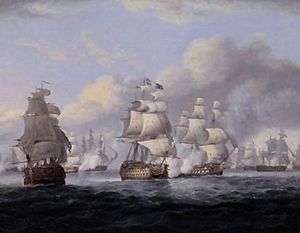Cornwallis's Retreat facts for kids
Quick facts for kids Cornwallis's Retreat |
|||||||
|---|---|---|---|---|---|---|---|
| Part of the naval operations during the War of the First Coalition | |||||||
 Cornwallis's Retreat, June 17, 1795, Thomas Luny |
|||||||
|
|||||||
| Belligerents | |||||||
| Commanders and leaders | |||||||
| Strength | |||||||
| 5 ships of the line 2 frigates (OOB) |
12 ships of the line 11 frigates (OOB) |
||||||
| Casualties and losses | |||||||
| 12 wounded | 29 killed and wounded | ||||||
Cornwallis's Retreat was an important naval battle during the French Revolutionary Wars. In this fight, a small British squadron of five large warships called ships of the line and two smaller, faster frigates was attacked by a much larger French fleet. The French had 12 ships of the line and 11 frigates.
The battle happened off the coast of Brittany, France, on June 16–17, 1795. The British squadron was led by Vice-Admiral William Cornwallis. He had been operating in the area and had captured some French merchant ships. In response, the main French fleet, led by Vice-Admiral Villaret de Joyeuse, sailed out to attack Cornwallis.
When the British spotted the much larger French fleet, Cornwallis knew he was outnumbered. He tried to escape into the open ocean, with the French chasing him. After a full day, some of the British ships started to slow down. The leading French ships began to catch up on the morning of June 17.
Cornwallis didn't want to leave his slower ships behind. So, he bravely turned his flagship, HMS Royal Sovereign, and the rest of his squadron around to fight the French. A tough battle began. Cornwallis even placed his own ship between the British and French forces to protect his squadron.
Cornwallis's strong defense, along with some clever signals sent to ships far away, made Villaret de Joyeuse think that the main British fleet was coming. Because of this, Villaret called off the battle on the evening of June 17 and ordered his ships to leave. This allowed Cornwallis to escape. He returned to Plymouth with his ships damaged but still together.
Villaret's fleet later met the main British fleet and was defeated in another battle called the Battle of Groix. Cornwallis was highly praised for his courage and skill in facing such a large enemy force. His actions are still seen as a great example of bravery in British naval history.
Contents
Why This Battle Happened
By 1795, Britain and France had been at war for over two years. The British Royal Navy was very strong in the Bay of Biscay, near France. They kept a close watch on French naval bases, especially the large port of Brest in Brittany.
The French navy had faced some tough times. In 1794, they lost seven ships in a big battle called the Glorious First of June. Then, in the winter of 1794–1795, five more ships were wrecked during a storm. This meant the French fleet needed a lot of repairs and wasn't ready to sail again until June 1795.
Meanwhile, a small French squadron was sent to escort merchant ships. The British Channel Fleet sent a squadron of five ships of the line and two frigates to patrol near Brest. This squadron was led by Vice-Admiral William Cornwallis on his ship, HMS Royal Sovereign. Cornwallis was a very experienced officer. He had fought in many wars and won important naval battles.
Cornwallis's Actions Near Belle Île
Cornwallis's squadron sailed southwest, past Ushant and down the Breton coast. On June 8, they spotted six ships. Cornwallis investigated and found a small French squadron with a large group of merchant ships. The French commander, Vence, first thought they were friendly ships. When he realized his mistake, he quickly ordered his ships to sail for safety near the island of Belle Île.
Cornwallis sent his faster ships ahead. They fired at the French merchant ships and their escorts. They managed to capture eight merchant ships loaded with wine and brandy. However, the French warships and most of the merchant ships reached the safe anchorage at Belle Île. The British ships couldn't get close enough to attack them because of the island's defenses and shallow water.
After capturing the merchant ships, Cornwallis sailed his squadron into the Bay of Biscay. He then turned back to patrol near Brest, hoping to find the French again.
The French Fleet Sails Out
At Brest, the French received messages that Vence's convoy was "blockaded" at Belle Île. Even though some officers said the anchorage couldn't really be blocked, Vice-Admiral Villaret de Joyeuse sailed from Brest on June 12 to "rescue" them. His fleet had nine ships of the line, nine frigates, and four smaller ships.
On June 15, Villaret's fleet met Vence's squadron. Vence had already sent the rest of his convoy safely to Brest. The combined French fleet then headed back towards Brest.
On June 16, at 10:30 AM, the French fleet spotted Cornwallis's squadron. Cornwallis, expecting to find Vence's merchant convoy, didn't immediately realize the danger. He sent his frigate, Phaeton, to check out the ships.
The Retreat Begins
Captain Robert Stopford on Phaeton signaled to Cornwallis that the French fleet had 30 vessels. Cornwallis first misunderstood the signal, thinking the French ships were weaker than his own. He ordered his squadron to advance.
However, Stopford then signaled the exact size of Villaret's fleet. Cornwallis realized his mistake and immediately ordered his squadron to turn away and escape to the southwest. The French fleet, led by Villaret, immediately began to chase them.
As the chase continued into the Atlantic, the British squadron struggled to stay together. Two ships, Brunswick and Bellerophon, were sailing very slowly. To make them faster, their captains ordered heavy items like anchors, boats, and even some cannons to be thrown overboard.
The Battle and Clever Trick
During the night, Villaret split his forces to try and surround Cornwallis. By 9:00 AM on June 17, the leading French ship, Zélé, began firing at the British rearguard ship, Mars. The French frigate Virginie also attacked Mars with many broadsides (firing all cannons on one side).
The British ships fired back, even cutting holes in their sterns (the back of the ship) to place more cannons. This caused a lot of damage to their own ships. At one point, Zélé was damaged and fell back. Other French ships, including Droits de l’Homme, Formidable, and Tigre, then focused their fire on Mars.
Mars became badly damaged and slowed down, risking being captured. Captain Gower's Triumph was also hit hard. Seeing the danger, Cornwallis took decisive action. He ordered Mars to turn away and bravely sailed his flagship, Royal Sovereign, to protect Mars. Royal Sovereign fired powerful broadsides at the leading French ships, forcing them to retreat. The French continued to chase but stayed out of range.
At 6:40 PM, Villaret suddenly ordered his ships to turn back east and break off the chase. The French fleet disappeared over the horizon as the British continued west.
The reason for Villaret's retreat was a clever trick by the British frigate Phaeton. Phaeton had sailed ahead and sent signals that could be seen by the French. These signals, which the French knew how to read, suggested that a large British fleet was approaching from the northwest. Phaeton's captain, Stopford, even fired cannons and raised the Dutch flag to make it seem like allied ships were coming.
At 6:00 PM, some sails appeared on the horizon. These were actually just a small group of merchant ships, but Villaret believed they were the main British Channel Fleet. Convinced he was about to face a much larger force, he abandoned the chase.
What Happened Next
With the French gone, Cornwallis ordered his squadron north to Plymouth for repairs. All of his ships had some damage, especially Triumph and Mars. Triumph needed major repairs to its stern. Despite the heavy fighting, British casualties were very light, with only 12 men wounded on Mars and no other losses.
The French fleet had only light damage and 29 men killed or wounded. Villaret continued east, but a fierce storm hit, scattering his fleet. He managed to gather his ships again near Belle Île. However, his fleet was running low on supplies.
On June 22, as the French fleet sailed north towards Brest, the main British Channel Fleet appeared. This fleet, led by Lord Bridport, had sailed to protect a British landing force at Quiberon Bay.
Villaret believed the new British fleet was much stronger than his own. He tried to escape towards the French coast. Bridport's ships chased them, leading to the Battle of Groix on June 23. In this battle, three French ships were captured, and others were damaged. However, Bridport surprisingly called off the attack, which was criticized later.
In France, Villaret was blamed for not pressing his attack against Cornwallis. Some French officers claimed their captains didn't follow orders. Villaret himself blamed Captain Jean Magnac of Zélé, who was later dismissed from the French Navy.
In Britain, Cornwallis's actions were celebrated as a great achievement. He received thanks from both houses of Parliament. Historians have highly praised Cornwallis's "masterly retreat" and the bravery of his men. They see it as one of the finest examples of courage and calmness in British naval history.
Images for kids


